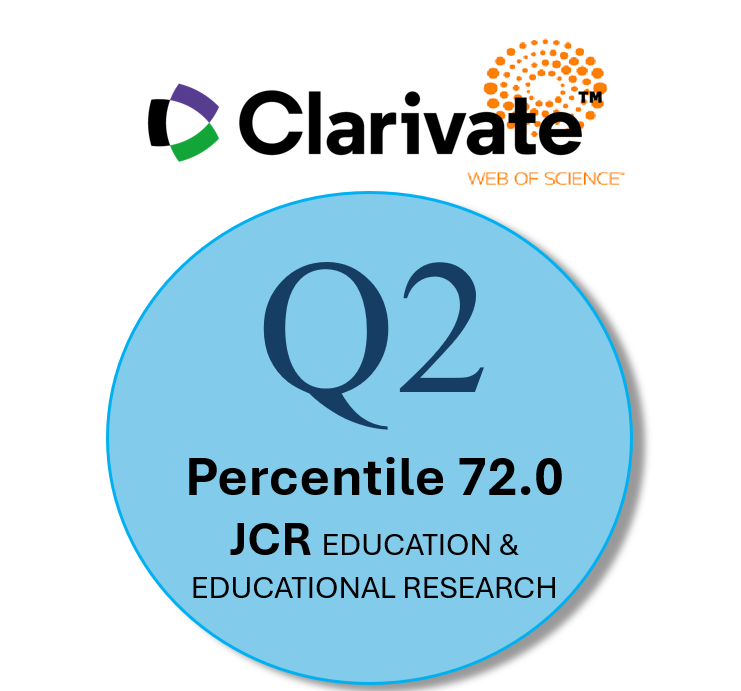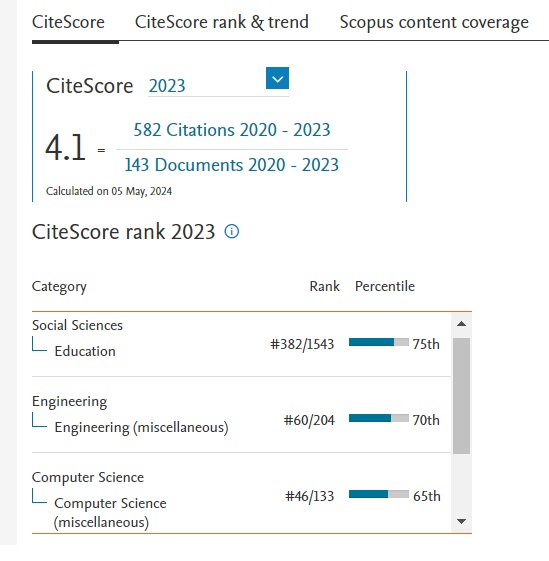Perfiles regulativos para un aprendizaje autodirigido en MOOC
Resumen
En la actual ecología del aprendizaje la participación en entornos de aprendizaje masivos y abiertos confiere un nuevo protagonismo al aprendiz en cuanto individuo que, conectado con otros y con los recursos a su alcance, aprende de manera autónoma. En la presente investigación nos apoyamos en la regulación educativa como mecanismo necesario de los procesos de autodirección del aprendizaje en los MOOC. En concreto, se analiza un proceso de enriquecimiento metacognitivo del diseño de un MOOC con la contribución de los propios aprendices. La autorregulación se utiliza como herramienta para personalizar y flexibilizar el aprendizaje masivo en una ecología tecnificada. Se propone una herramienta de perfilado de los aprendices en la autodirección de su aprendizaje en relación a tres ejes competenciales: motivacional, social y reflexivo. El análisis cualitativo de las aportaciones a los talleres de co-diseño de un test del perfil de aprendiz y los resultados obtenidos en la implementación del test en el MOOC, aportan los resultados siguientes: a) las características de los perfiles regulativos y medidas de apoyo al aprendizaje autodirigido desde la perspectiva de los participantes; b) el comportamiento evolutivo de los distintos perfiles y su uso como instrumento en una autodirección regulada del aprendizaje en MOOC.
Descargas
-
Resumen826
-
PDF748
Citas
Bannert, M. & Reimann, P. (2012). Supporting self-regulated hypermedia learning through prompts. Instructional Science, 40(1), 193-211. http://www.jstor.org/stable/43575195
Bannert, M., Sonnenberg, C., Mengelkamp, C., & Pieger, E. (2015). Short- and long-term efects of students’ self-directed metacognitive prompts on navigation behavior and learning performance. Computers in Human Behavior, 52, 293–306. https://doi.org/10.1016/j.chb.2015.05.038
Baturay, M. H. (2015). An overview of the world of MOOCs. Social and Behavioral Sciences 174, 427-433. http://dx.doi.org/10.1016/j.sbspro.2015.01.685
Beckers, J., Dolmans, D. H. J. M., & Van Merriënboer, J. J. G. (2016). E-portfolios enhancing students’ self-directed learning: A systematic review of influencing factors. Australasian Journal of Educational Technology, 32(2), 32–46. https://doi.org/10.14742/ajet.2528
Carré, P. (2010). L’autodirection des apprentissages. In P. Carré., A. Moisan., & D. Poisson (Eds.), L’autoformation. Perspectives de recherche (pp. 117-169). Presses Universitaires France. https://doi.org/10.3917/puf.carre.2010.02.0117
Cosnefroy, L. & Carré, P. (2014). Self-regulated and self-directed learning : Why don’t some neighbors communicate? International Journal of Self-Directed Learning, 11(2), 1-12. https://hal.parisnanterre.fr/hal-01410802/document
Fournier, H., Kop, R., & Durand, G. (2014). Challenges to research in MOOCs. MERLOT Journal of Online Learning and Teaching, 10(1), 1–15. https://jolt.merlot.org/Vol10_No1.htm
Garrison, D. R. (1997). Self-directed learning: Toward a comprehensive model. Adult Education Quarterly, 48(1), 18–33. https://doi.org/10.1177/074171369704800103
González-Sanmamed, M., Muñoz-Carril, P. & Santos-Caamaño, F. (2019). Key components of learning ecologies. A Delphi study. British Journal of Educational Technology, 50(4), 1639-1655. https://doi.org/10.1111/bjet.12805
Hadwin, A.F., Järvelä, S. & Miller, M. (2011). Self-regulated, co-regulated, and socially shared regulation of learning. In B. Zimmerman & D. H. Schunk (Eds.), Handbook of Self-Regulation of Learning and Performance (pp. 65-84). Routledge.
Hadwin, A. F. & Järvelä, S. (2011). Social aspects of self-regulated learning: Where social and self meet in the strategic regulation of learning. Teachers College Records, 113(2), 235-239. https://doi.org/10.1177/016146811111300201
Hadwin, A. F., Järvelä, S., & Miller, M. (2017). Self-regulation, co-regulation and shared regulation in collaborative learning environments. In D. Schunk, & J. Greene, (Eds.). Handbook of Self-Regulation of Learning and Performance (2nd Ed.). (pp. 83-106). Routledge.
Hiemstra (2013a). Self-directed learning: Why do most instructors still do it wrong? International Journal of Self-Directed Learning, 10 (1), 23-34. https://tinyurl.com/37u2pus8
Hiemstra, R. (2013b). Facilitating adult self-directed learning. In R. Hiemstra & P. Carré (Eds.), A feast of learning: International perspectives on adult learning and change (pp. 25-46). Information Age Publishing.
IMS-LIP (2001) Learner Information Profile. http://www.imsglobal.org/profiles/lipinfo01.html
Järvelä, S., & Järvenoja, H. (2011). Socially constructed self-regulated learning and motivation regulation in collaborative learning groups. Teachers College Record, 113(2), 350-374.
Jennett, P. A. (1992). Self-directed learning: a pragmatic view. Journal of Continuing Education in the Health Professions, 12(2), 99–104. https://doi.org/10.1002/chp.4750120208
Kaplan, J., de Montalembert, M., Laurent, P., & Fenouillet, F. (2017). ERICA–an instrument to measure individual and collective regulation of learning. European Review of Applied Psychology, 67(2), 79-89. https://doi.org/10.1016/j.erap.2017.01.001
King, C. (2011). Fostering self-directed learning through guided tasks and learner reflection. Studies in Self-Access Learning Journal, 2(4), 257-267. https://sisaljournal.org/archives/dec11/king/
Knowles, M. S. (1975). Self-directed learning. Association Press.
Kramarski, B., Desoete, A., Bannert, M., Narciss, S., & Perry, N. (2013). New Perspectives on Integrating Self-Regulated Learning at School. Education Research International, 2013. https://doi.org/10.1155/2013/498214
Li, H., Majumdar, R., Chen, M. A. & Ogata H. (2021). Goal-oriented active learning (GOAL) system to promote reading engagement, self-directed learning behavior, and motivation in extensive reading. Computers & Education, 171 (2). http://dx.doi.org/10.1016/j.compedu.2021.104239
López Costa, M. (2016). Perfiles de participación en la red de los estudiantes universitarios y sus repercusiones en el aprendizaje. RED-Revista de Educación a Distancia, 49(10), 1-20. http://dx.doi.org/10.6018/red/49/10
Martin, N., Kelly, N., & Terry, P. (2018). A framework for self-determination in massive open online courses: Design for autonomy, competence, and relatedness. Australasian Journal of Educational Technology, 34(2), 35-55. https://doi.org/10.14742/ajet.3722
Mentz, E., De Beer, J. & Bailey, R. (eds.) (2019). Self-directed learning for the 21st century: Implications for Higher Education. AOSIS. https://doi.org/10.4102/aosis.2019.BK134
Payne, S. (2021). Using an e-portfolio system to evaluate student learning outcomes and to foster more self-direction within the curricula. International Journal of Self-Directed Learning, 18(1), 1–9. https://tinyurl.com/4btdphye
Pintrich P. R. (2000). The role of goal orientation in self-regulated learning. In Boekaerts M., Pintrich P. R., Zeidner M. (eds). Handbook of Self-Regulation, 452–502. Academic Press.
Piotrowski, M. (2020). Relationship of self-directed learning and resilience in healthcare middle managers. International Journal of Self-Directed Learning, 17(1), 19-38. https://tinyurl.com/t4bw4fep
Porter, T. H., Rathert, C., & Lawong, D. A. (2020). Self-directed learning: A qualitative study of doctoral student experiences. International Journal of Self-Directed Learning, 17(1), 1-18. https://tinyurl.com/t4bw4fep
Rogers, T. (2004). Towards conscious self-directed learning. Human Resources Magazine, 9(5), 22-23. EBSCOhost Business Source Complete.
Saeid, N. & Eslaminejad, T. (2017). Relationship between student’s self-directed-learning readiness and academic self-efficacy and achievement motivation in students. International Education Studies, 10(1), 225-232. https://doi.org/10.5539/ies.v10n1p225
Tekkol, A. & Demirel, M. (2018) An Investigation of self-directed learning skills of undergraduate students. Frontiers in Psychology, 9, 1-14. https://doi.org/10.3389/fpsyg.2018.02324
Winne, P. H. (2015). What is the state of the art in self-, co-and socially shared regulation in CSCL?. Computers in Human Behavior, 52, 628-631. https://doi.org/10.1016/j.chb.2015.05.007
Zhu, M., & Bonk, C. J. (2019). Designing MOOCs to facilitate participant self-directed learning: An analysis of instructor perspectives and practices. International Journal of Self-Directed Learning, 16(2), 39-60. http://dx.doi.org/10.24059/olj.v23i4.2037
Zhu, M., Bonk, C.J. & Doo, M.Y. (2020). Self-directed learning in MOOCs: Exploring the relationships among motivation, self-monitoring, and self-management. Educational Technology Research & Development 68 (5), 2073–2093. https://doi.org/10.1007/s11423-020-09747-8
Zimmerman, B. J. (2000). Attaining Self-regulation: A social cognitive perspective. In M. Boekaerts, P.R. Pintrich & M. Zeidner (Eds.), Handbook of self-regulation (pp. 13-39). Academic Press. http://dx.doi.org/10.1016/B978-012109890-2/50031-7
Derechos de autor 2022 Revista de Educación a Distancia (RED)

Esta obra está bajo una licencia internacional Creative Commons Atribución-NoComercial 4.0.
Las obras que se publican en esta revista están sujetas a los siguientes términos:
1. El Servicio de Publicaciones de la Universidad de Murcia (la editorial) conserva los derechos patrimoniales (copyright) de las obras publicadas, y favorece y permite la reutilización de las mismas bajo la licencia de uso indicada en el punto 2.
2. Las obras se publican en la edición electrónica de la revista bajo una licencia Creative Commons Reconocimiento-NoComercial-SinObraDerivada 3.0 España (texto legal). Se pueden copiar, usar, difundir, transmitir y exponer públicamente, siempre que: i) se cite la autoría y la fuente original de su publicación (revista, editorial y URL de la obra); ii) no se usen para fines comerciales; iii) se mencione la existencia y especificaciones de esta licencia de uso.
3. Condiciones de auto-archivo. Se permite y se anima a los autores a difundir electrónicamente las versiones pre-print (versión antes de ser evaluada) y/o post-print (versión evaluada y aceptada para su publicación) de sus obras antes de su publicación, ya que favorece su circulación y difusión más temprana y con ello un posible aumento en su citación y alcance entre la comunidad académica. Color RoMEO: verde.














